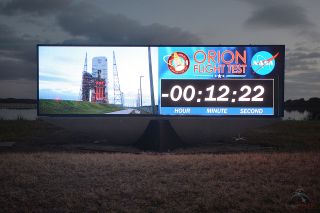NASA's Historic Countdown Clock is Ticking Again for Launch Spectators

NASA's historic countdown clock, which the space agency retired and replaced two years ago, has been restarted for a new audience of launch spectators.
Relocated from NASA's Kennedy Space Center press site, where it stood for more than four decades, to just outside the entrance to the Florida spaceport's visitor complex, the clock was used to count down to its own rededication last month.
"3, 2, 1 Lift-off!" announced Therrin Protze, chief operating officer for NASA's Kennedy Space Center Visitor Complex, as confetti launched from behind the 10-foot-tall (3 meters) and 26-foot-long (8 m) clock on March 1. "Outstanding!" [Photos of Kennedy Space Center: NASA's Historic Spaceport]
Considered one of the most-watched time-keeping devices in the world, the blue and black countdown clock first went into service before the second moon landing mission.
"This clock was built back in '69 and was in place, its first launch was Apollo 12," recounted Bob Cabana, director of the Kennedy Space Center and a former shuttle astronaut. "It supported all the rest of the Apollo missions, the Apollo-Soyuz Test Project, Skylab and 30 years of space shuttle. It really is historic."
The clock was damaged by a hurricane in 2004, but NASA was able to repair it to finish out the space shuttle program seven years later.
"When the shuttle program ended, we decided it was time to move into the 21st century," said Cabana said.
Get the Space.com Newsletter
Breaking space news, the latest updates on rocket launches, skywatching events and more!

The press site's new digital clock features a full-color video display, similar to the type found in sports stadiums. It was put into service in December 2014 for NASA's Exploration Flight Test-1, the first launch of the Orion spacecraft that is being developed to fly astronauts beyond low Earth orbit.
"[It's] absolutely fabulous if you go out there and see it, big screen graphics and everything, but we didn't want to lose the historical significance to this one," stated Cabana. "It is actually on the national register of historic facilities."
The Visitor Complex, under NASA's direction, has outfitted the historic clock with a new control system and easier to replace lights used to form its digits so that it may continue to be used to count down for many more future launches.
"We were able to refurbish and place it here for everybody to remember the importance of this countdown clock – and what it represents here at NASA," Cabana said.
Watch a video of the rededication of NASA’s historic countdown clock at collectSPACE.
Follow collectSPACE.com on Facebook and on Twitter at @collectSPACE. Copyright 2016 collectSPACE.com. All rights reserved.
Join our Space Forums to keep talking space on the latest missions, night sky and more! And if you have a news tip, correction or comment, let us know at: community@space.com.

Robert Pearlman is a space historian, journalist and the founder and editor of collectSPACE.com, an online publication and community devoted to space history with a particular focus on how and where space exploration intersects with pop culture. Pearlman is also a contributing writer for Space.com and co-author of "Space Stations: The Art, Science, and Reality of Working in Space” published by Smithsonian Books in 2018. He previously developed online content for the National Space Society and Apollo 11 moonwalker Buzz Aldrin, helped establish the space tourism company Space Adventures and currently serves on the History Committee of the American Astronautical Society, the advisory committee for The Mars Generation and leadership board of For All Moonkind. In 2009, he was inducted into the U.S. Space Camp Hall of Fame in Huntsville, Alabama. In 2021, he was honored by the American Astronautical Society with the Ordway Award for Sustained Excellence in Spaceflight History.

